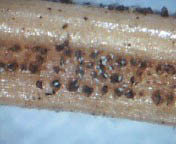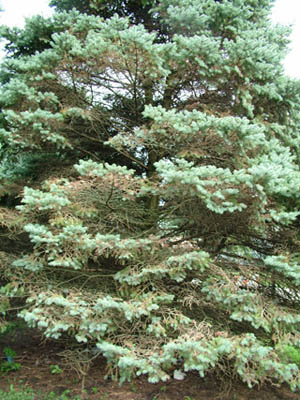Sparse Spruce | |
|---|---|
| April 30, 2008 | |
|
Do you have spruce trees that appear similar to the one in the photo? Did you notice last year that patches in your spruce tree had apparently healthy new growth but purplish brown 1-year-old needles? These symptoms are caused by a fungal disease, Rhizosphaera needle cast. Affected needles are cast (dropped). Evergreens do not re-foliate along the branch but continue to grow at branch tips. If disease is severe for a few years, bare areas appear scattered throughout the tree, as seen in this image. Want to be certain you have identified this disease correctly? One way is to consult the nearest plant diagnostic clinic, such as the U of I Plant Clinic (http://plantclinic.cropsci.uiuc.edu/). There is a fairly simple test you can try on your own to confirm the presence of the causal fungus. This fungus forms black fruiting bodies about the size of a pinhead. In humid conditions, the fruiting bodies emerge through the stomates on the needle, as seen below.  Place some discolored needles in a plastic bag with a damp paper towel. Within 24 hours, these fruiting bodies will be visible in infected needles. If you had this disease on spruce last year, and if you are able to confirm it now, consider treatment to protect the new growth. Chemicals are effective if the disease is caught early. Two applications are recommended: Spray when the new needles are half-grown (or as soon as the bud caps fall off), again when needles are fully elongated. Some products to choose from include copper (Camelot), chlorothalonil (Chlorostar, Daconil, Echo, Manicure), mancozeb (Protect), or two products that have some systemic activity in the plant: Spectro (chlorothalonil + thiophanate-methyl) or TwoSome (chlorothalonil + fenarimol). Homeowner options are listed in the Home, Yard, and Garden Pest Guide. | |
| Author: | Nancy Pataky |

 .
.